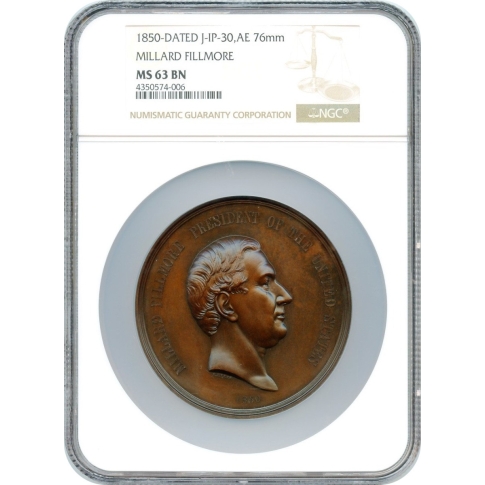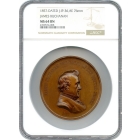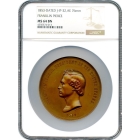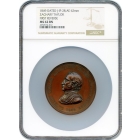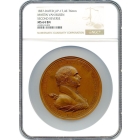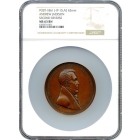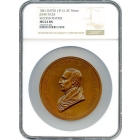Indian Peace Medal - 1850 Millard Fillmore, J-IP-30 AE 76mm NGC MS63
Peace Medals were instrumental in building relationships with the various Indian Tribes. American Presidents (and their Colonial predecessors) used Indian Peace Medals as a way of placating various tribes and/or to build alliances with them. The recipients valued them highly, for they conferred a prestige that was recognized throughout the nation. The Bureau of Indian Affairs considered them crucial and the Presidents for whom they were issued also knew their importance. Many images from the "Old West" show Indians proudly wearing their Peace Medals (sometimes more than one). Generally, bronze medals were not used for presentation purposes, but in some cases, they were silver-plated and either given, sold, or traded away by unscrupulous individuals to unwitting recipients.
NGC total census of 10 medals. 1 is in this Choice Brilliant Uncirculated grade with 10 finer (1 MS66 is finest at this time).
Millard Fillmore Indian Peace Medals
It was a friend and patron of President Millard Fillmore, Ransom H. Gillet, a respected Democratic politician from New York, who selected the artist to craft the image of for the Fillmore IPM. A month after Fillmore took office, on August 8, 1850, Gillet wrote to the president, "Permit me to introduce Mr. Joseph Wilson [sic], the artist, whom I named to you yesterday. He is a most worthy young man in whom I take great interest. Be so glad as to give him time to model your bust, at such hours as you can spare." Fillmore told the Indian Office to hire Willson "to design and execute the Medal for presentation by your Office to the Indians." The artist was to be paid the typical salary, and the design had to be approved by the Interior Department and the Commissioner of Indian Affairs.
The obverse engravings of the medals was not done by Willson, but by his colleague, Salathiel Ellis, who worked with Willson in New York City. The reverses of the medals, however, were engraved by Willson. The traditional clasped hands and 'Peace and Friendship' slogan were gone. They were replaced by an Indian wrapped in a blanket with a feathered headdress atop his head. He faced a white man wearing civilian garb and sporting a hat. The two men stood in front of an unfurled American flag, and a plow and an ax are set between them. In the background is found a lake, trees, hills, cattle and a farmhouse. Above the flag is found three chain links with the slogan, 'LABOR, VIRTUE, HONOR' within them. The portrait lathe was not employed to create the Fillmore IPMs; Willson and Ellis were die sinkers and used their skills to produce the dies. These medals were produced in two sizes because the Indian Office decided to stop producing the smaller ones. The number of medals to be minted for Fillmore was decided by the amount of Taylor medals left over when he died. The total number of Fillmore IPMs created was 281. Twenty-four of them (twelve of each size) were sent to Luke Lea, Commissioner of Indian Affairs, in New York, on June 8, 1851. The other 257 were express shipped to Washington that same day. The artists were paid $980 to engrave the four dies, and $520 for striking and ringing the medals, totaling $1,500. A majority of the Fillmore medals were presented to Indians, for when the next medals were being planned, the Indian Office sent just 25 large, 40 medium, and five small (not Fillmore medals) to be melted down to supply silver.
Millard Fillmore and the Indians
As President, Millard Fillmore developed a reputation as being anti-Catholic, anti-Semitic, anti-immigrant and anti-black. And he didn't think much of the Indians either. The Compromise of 1850 was signed into law by Fillmore, resulting in California joining the Union and slavery was allowed in territories with significant Indian populations, including modern-day Arizona, Nevada and Utah, and sections of Colorado and Wyoming. In December 1850 he told Congress that 124,000 Indians had now come under US jurisdiction, and wanted Congress to "provide for the raising of one or more regiments of mounted men" in order to protect white settlers in the new lands.
"Texas and New Mexico are surrounded by powerful tribes of Indians, who are a source of constant terror and annoyance to the inhabitants," said Fillmore. "Separating into small predatory bands, and always mounted, they overrun the country, devastating farms, destroying crops, driving off whole herds of cattle, and occasionally murdering the inhabitants or carrying them off in captivity. The great roads leading into the country are infested with them, whereby traveling is rendered extremely dangerous and immigration is almost entirely arrested."
It was in 1851 that federal Indian agents negotiated 18 secret removal treaties with California tribes. There were 402 Indian leaders, who represented 139 tribes or bands, and they agreed to give up their land, exchanging it for reservations, schools, and livestock and dry goods. However, the commissioners who negotiated those agreements were considered part of a "corrupt Indian system" because most of the deals were negotiated fraudulently. The Senate had issues with the substance of the treaties and refused to ratify them, leaving unresolved the Indian titles to the land. There were Indian reservations designated to be developed in California. But lawmakers there felt they might be located on valuable agricultural and mineral land (the Gold Rush was in full swing then). Therefore the California Assembly, in 1852, proposed that senators "induce the federal government to remove the Indians of this state beyond its jurisdiction."
Millard Fillmore Indian Peace Medals for Indians and Collectors
The medals were dated 1850, and available in two sizes: 76 mm and 62 mm. R.W. Julian writes, "It is quite probable that the then raging controversy over Franklin Peale and his medal operations within the mint may have influenced the government into putting the whole matter into the hands of private contractors…the medals appear to have been struck in New York City." The 62 mm medal was the one usually sold to collectors after 1860. However, by 1892, the bigger size was typically produced for sale to the public.
| Grading Service | NGC |
|---|---|
| Year of Issue | 1850 |
| Grade | MS63 |
| Denom Type | U.S. Mint Medal |
| Mint Location | Philadelphia |
| Designation | NONE |
| Circ/UnCirc | Uncirculated |
| Strike Type | Business |
| Holder Variety | Millard Fillmore: J-IP-30, AE, 76mm |
| Grade Add On | NONE |
| Holder Type | N/A |

